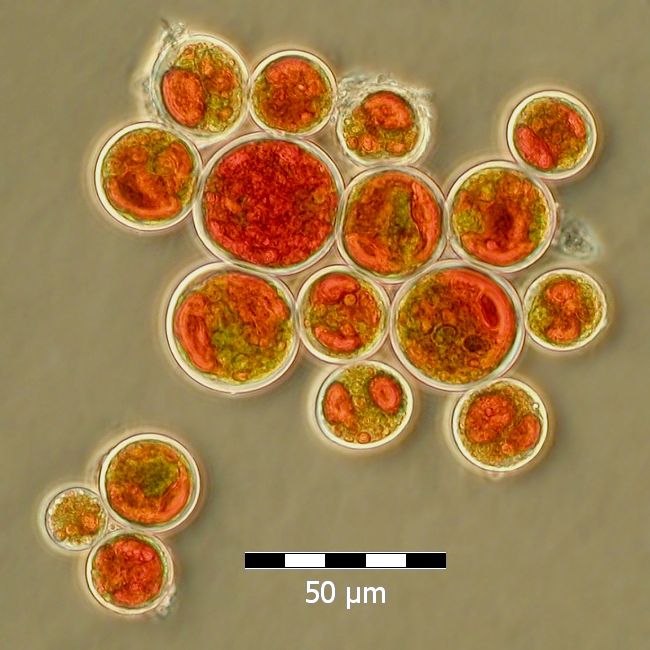*Fact-checked and upated by: Valentino Muza
Zanthin® is a stabilized form of astaxanthin with potent antioxidant and anti-inflammatory properties.
Zanthin is a patented astaxanthin that is manufactured through a proprietary processing technique. This review details its potential advantages over generic astaxanthin supplements:
- Patented. There are multiple patents covering the preparation of Zanthin as well as its ability to promote eye, joint, and cardiovascular health.
- Clinically researched. The vision and joint health benefits of Zanthin are supported by clinical studies, although they are still not conclusive, and much more research is needed to fully understand astaxanthin’s effects on health.
- Stabilized. Supercritical CO2 extraction combined with a proprietary peroxidation blocker extends the life span of the supplement for years.
Overview
Zanthin is a patented supplement primarily consisting of the carotenoid astaxanthin. It was developed and is manufactured in Eustis, Florida, by Valensa International, a subsidiary of the public company East India Distilleries (EID) Parry.
Along with lutein and zeaxanthin, astaxanthin is a lipid-soluble pigment that is commonly incorporated into nootropic supplements due to its high store of decentralized electrons that promote antioxidation. The pigment may be most popularly recognized for the bold, pink-red hue it imbues into the external appearance of flamingos, salmon, lobster, and numerous red-colored aquatic creatures.
In the case of Zanthin, its astaxanthin content comes from the microalgae Haematococcus pluvialis (H. pluvialis) grown by Alimtec in the Elqui valley of Chile. After the mass of microalgae is concentrated, cracked in specialized equipment, dried, granulated, and vacuum sealed, it is sent to Florida to undergo supercritical CO2 extraction.
This extensive manufacturing process helps maintain the wide-ranging health benefits of Zanthin, which include improving vision, joint health, cardiovascular health, and immunity.1
How Zanthin Works
As an antioxidant, Zanthin can impart a neuroprotective effect that protects the brain and neurons from oxidative stress, as well as a photoprotective effect to counteract harmful ultraviolet (UV) damage. The presence of astaxanthin may further have an anti-inflammatory effect that promotes the microcirculation of blood and nutrients near the eye.

Zanthin Patents
Zanthin Extraction
Valensa utilizes a proprietary supercritical CO2 extraction process to ensure that Zanthin is pure and free from solvents. This process is covered by the German patent and trademark office (DPMA) under DE Patent 212015000031U1.
Zanthin for Joint Health
There are more than 10 U.S. and DE patents affirming the use of Zanthin in supplements to improve joint health. The most recent one (U.S. Patent 9913810B2) claims that the supplement can treat and alleviate symptoms of joint pain.
Zanthin for Eye Health
U.S. Patent 9610313B2 covers the formulation for a vision supplement that mixes carotenoids — including the astaxanthin of Zanthin — with omega-3 essential oils.
Zanthin for Cardiovascular Health
A supplement consisting of a combination of Zanthin and phospholipids has been shown to promote the maintenance of cardiovascular health (DE 212015000033U1).

Zanthin Nutritional Supplement Uses
The predominating uses of Zanthin are for joint and eye health, but it may deliver a number of other potential health benefits.
Joint Supplements
As a potent antioxidant, Zanthin is capable of protecting the joints from the detrimental impact of oxidative stress by neutralizing excess reactive oxygen species (ROS). Research has also shown that astaxanthin supplements can inhibit inflammatory biomarkers such as TNF-α, NF-kB, i-NOS, and COX-2. Diminishing oxidative stress and inflammation are both critical processes for maintaining optimal joint function and stability.
Vision Supplements
The antioxidative and anti-inflammatory capacity of Zanthin can also benefit vision by protecting against macular degeneration, UV radiation, and ROS around the eyes, as well as minimizing eye strain and enhancing visual accommodation. Other potential, albeit not research-backed, benefits to vision performance include improvements in contrast sensitivity and recovery from flash blindness.
More on astaxanthin for vision.
Nootropic Supplements
By crossing the blood-brain barrier, Zanthin is able to defend brain cells against the gradually deteriorating effects of aging and neurodegenerative disorders like Alzheimers. The potential nootropic effects of the supplement are still in its early stages of clinical investigation.
More on astaxanthin as a nootropic.
Cardiovascular Supplements
Zanthin may benefit cardiovascular health through 2 distinct mechanisms:
- Spanning the lipid bilayer and eliminating excess ROS
- Preventing lipid peroxidation, or the buildup of “bad” cholesterol like low-density lipoprotein (LDL)
Due to the similarity of their mechanisms, Zanthin and omega-3 fatty acid supplements are often paired together for cardiovascular health.
Immune Supplements
It is also possible that the antioxidative effects of Zanthin facilitate immunomodulating activity, including the proliferation of T-cells, B-cells, and natural killer cells that defend the body against illnesses and potentially harmful cytokines.
Zanthin Advantages
Zanthin Natural Astaxanthin may offer some advantages over generic astaxanthin supplements:
- Clinical backing: A small but noteworthy number of randomized and controlled clinical trials has suggested benefits of H. pluvialis-derived astaxanthin supplements for vision and joint health.
- Safety compliant: The all-natural supplement is hypoallergenic, gluten-safe, entirely vegetarian, and free of solvents and growth-modified hormones (GMO). The U.S. Food and Drug Administration (FDA) has granted Generally Recognized as Safe (GRAS) status to astaxanthin supplements derived from H. pluvialis.
- Stable: Relative to other astaxanthin supplements, Zanthin boasts a considerably longer shelf life due to a manufacturing procedure that unites DeepExtract® high pressure, supercritical CO2 extraction and Peroxidation Blocker Stabilization technology (O2 B®).
- Traceable: Users can trace the preparation of the supplement all the way to its originating microalgae source H. pluvialis, which a sister company cultivates in Chile.
- Multifaceted: Zanthin is highly versatile and has applications in joint health, cardiovascular health, vision, brain health, and immunity.
Zanthin Research
Animal Research
Zanthin (2 mg) as a component of FlexPro MD may alleviate joint discomfort
This study examined the effect of a multi-ingredient supplement containing krill oil, hyaluronic acid, and 2 mg of Zanthin on male mice. The supplement significantly inhibited pro-inflammatory cytokines — including interleukin-6 (IL-6), tumor necrosis factor-α (TNF-α), and IL-1β — while also elevating levels of the anti-inflammatory cytokine IL-10.
- The researchers concluded that “since FlexPro MD can inhibit the production of matrix metalloproteinases at the transcriptional level, FlexPro MD might be used as anti-inflammatory supplements for arthritis.”2
Human Research
Clinical trials have shown the ability of Zanthin to promote vision, particularly when taken as part of a multi-supplement formula. In addition, there is an ongoing, unpublished study that found Zanthin reduced joint discomfort more so than the standard treatment of glucosamine and chondroitin.
Zanthin (4 mg) as part of a multi-supplement formula may improve visual function and acuity
The Carotenoids in Age-Related Maculopathy Italian Study (CARMIS) was a blinded, randomized, placebo-controlled trial assessing the effect of carotenoids on the vision of 145 patients with age-related macular degeneration. After taking either a control or a combination of 4 mg of Zanthin and various carotenoids, vitamins, and minerals for 2 years, the Zanthin group displayed statistically significant improvements in visual acuity, contrast sensitivity, and retinal function.
- The researchers concluded that “lutein/zeaxanthin combined with additional carotenoids (astaxanthin) and antioxidants/minerals (including zinc) significantly improved some psychophysical (visual acuity and contrast sensitivity) and psychometric (visual function) parameters.”3
Zanthin Dosage
- Successful clinical trials have used 2 – 4 mg daily serving sizes.
- Single supplement Zanthin is typically available in 4 – 12 mg capsules or softgels.
- Zanthin (4 mg) is most widely offered as a component of multi-ingredient formulas, such as Valensa’s EyePro MD for vision and FlexPro MD for joints.
Zanthin vs AstaReal
Zanthin isn’t the only patented form of natural astaxanthin out there. Another world-leading brand that produces patented astaxanthin is called AstaReal.
In fact, AstaReal started developing and producing patented astaxanthin in 1994, making it a pioneer in this field.
Both brands use the microalgae Haematococcus pluvialis to obtain astaxanthin. The quality is top-notch in both cases; non-GMO, vegetarian-friendly, and hypo-allergenic. Both Zanthin and AstaReal follow strict proprietary processes to ensure quality and safety of their patented end-product.
The question is, what are key differences between Zanthin and AstaReal? Which one is safer, healthier, higher-quality, and better value for your money?
Differences
Zanthin is produced in Florida from Chilean microalgae, whereas AstaReal is produced in Moses Lake, Washington. Each company has their own proprietary extraction process which can impact the final product and bioavailability, to what extent, it’s difficult to tell.
- AstaReal hasn’t only been around for longer than Zanthin, but it is also backed by over 80 human clinical studies, making it the most evidenced natural astaxanthin supplement on the market.
Zanthin’s advantage is that it uses a so-called O2B® peroxidation blocker which prolongs shelf-life of Zanthin to 4 years. AstraReal’s shelf-life, meanwhile, is between 2-3 years (depends on the version of the product, there are different forms available).
The last notable difference is the price. AstaReal is found in products like Doctor’s Best Astaxanthin on iHerb, costing $22.40 per bottle (4mg per serving, 90 capsules). Zanthin is used in supplements like NOW Foods Astaxanthin, which costs $12.23 (6mg per serving, 60 capsules) on iHerb. Similar products are also available on Amazon and other retailers, so make sure to look around for the best deal.
Overall, if we had to pick between the two, we’d go with AstaReal, as it has a longer track-record in the industry. However, both are looking on par in terms of quality. If you’re on a budget, Zanthin is the one to consider—it tends to cost less while offering a high-quality patented form of astaxanthin that has an even longer shelf-life than AstaReal.
Supplements in Review Recommendation
- Zanthin®, 4 mg.
Zanthin may alleviate joint pain and improve vision. Among the various potential health advantages of taking Zanthin, only its use for vision and joint health have some clinical backing. However, the antioxidant and anti-inflammatory properties of astaxanthin supplements are well-documented, which means Zanthin is potentially beneficial for the brain, heart, and immune system.
Start with a 4 mg dose of Zanthin. Clinical studies examining natural astaxanthin supplements like Zanthin have used 4 mg of the supplement per day. This amount is also the most common dose among Zanthin-based products currently on the market.

Leave a Reply